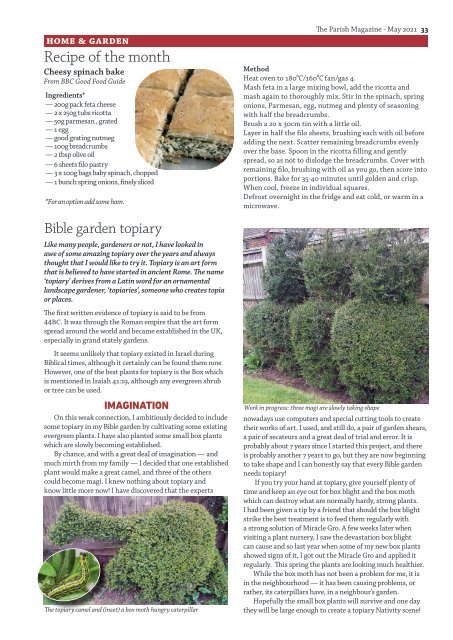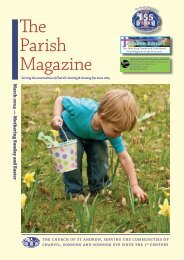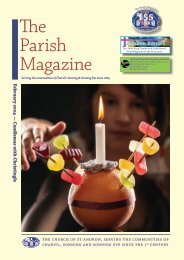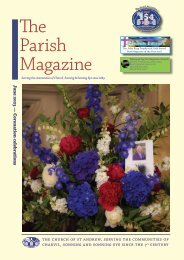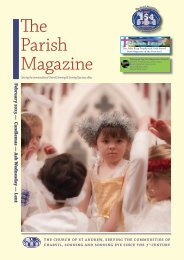The Parish Magazine May 2021
Serving the communities of Charvil, Sonning and Sonning Eye since 1869
Serving the communities of Charvil, Sonning and Sonning Eye since 1869
Create successful ePaper yourself
Turn your PDF publications into a flip-book with our unique Google optimized e-Paper software.
HOME & GARDEN<br />
Recipe of the month<br />
Cheesy spinach bake<br />
From BBC Good Food Guide<br />
Ingredients*<br />
— 200g pack feta cheese<br />
— 2 x 250g tubs ricotta<br />
— 50g parmesan , grated<br />
— 1 egg<br />
— good grating nutmeg<br />
— 100g breadcrumbs<br />
— 2 tbsp olive oil<br />
— 6 sheets filo pastry<br />
— 3 x 100g bags baby spinach, chopped<br />
— 1 bunch spring onions, finely sliced<br />
*For an option add some ham.<br />
Bible garden topiary<br />
Like many people, gardeners or not, I have looked in<br />
awe of some amazing topiary over the years and always<br />
thought that I would like to try it. Topiary is an art form<br />
that is believed to have started in ancient Rome. <strong>The</strong> name<br />
‘topiary’ derives from a Latin word for an ornamental<br />
landscape gardener, ‘topiaries’, someone who creates topia<br />
or places.<br />
<strong>The</strong> first written evidence of topiary is said to be from<br />
44BC. It was through the Roman empire that the art form<br />
spread around the world and became established in the UK,<br />
especially in grand stately gardens.<br />
It seems unlikely that topiary existed in Israel during<br />
Biblical times, although it certainly can be found there now.<br />
However, one of the best plants for topiary is the Box which<br />
is mentioned in Isaiah 41:19, although any evergreen shrub<br />
or tree can be used.<br />
IMAGINATION<br />
On this weak connection, I ambitiously decided to include<br />
some topiary in my Bible garden by cultivating some existing<br />
evergreen plants. I have also planted some small box plants<br />
which are slowly becoming established.<br />
By chance, and with a great deal of imagination — and<br />
much mirth from my family — I decided that one established<br />
plant would make a great camel, and three of the others<br />
could become magi. I knew nothing about topiary and<br />
know little more now! I have discovered that the experts<br />
<strong>The</strong> topiary camel and (inset) a box moth hungry caterpillar<br />
<strong>The</strong> <strong>Parish</strong> <strong>Magazine</strong> - <strong>May</strong> <strong>2021</strong> 33<br />
Method<br />
Heat oven to 180⁰C/160⁰C fan/gas 4.<br />
Mash feta in a large mixing bowl, add the ricotta and<br />
mash again to thoroughly mix. Stir in the spinach, spring<br />
onions, Parmesan, egg, nutmeg and plenty of seasoning<br />
with half the breadcrumbs.<br />
Brush a 20 x 30cm tin with a little oil.<br />
Layer in half the filo sheets, brushing each with oil before<br />
adding the next. Scatter remaining breadcrumbs evenly<br />
over the base. Spoon in the ricotta filling and gently<br />
spread, so as not to dislodge the breadcrumbs. Cover with<br />
remaining filo, brushing with oil as you go, then score into<br />
portions. Bake for 35-40 minutes until golden and crisp.<br />
When cool, freeze in individual squares.<br />
Defrost overnight in the fridge and eat cold, or warm in a<br />
microwave.<br />
Work in progress: three magi are slowly taking shape<br />
nowadays use computers and special cutting tools to create<br />
their works of art. I used, and still do, a pair of garden shears,<br />
a pair of secateurs and a great deal of trial and error. It is<br />
probably about 7 years since I started this project, and there<br />
is probably another 7 years to go, but they are now beginning<br />
to take shape and I can honestly say that every Bible garden<br />
needs topiary!<br />
If you try your hand at topiary, give yourself plenty of<br />
time and keep an eye out for box blight and the box moth<br />
which can destroy what are normally hardy, strong plants.<br />
I had been given a tip by a friend that should the box blight<br />
strike the best treatment is to feed them regularly with<br />
a strong solution of Miracle Gro. A few weeks later when<br />
visiting a plant nursery, I saw the devastation box blight<br />
can cause and so last year when some of my new box plants<br />
showed signs of it, I got out the Miracle Gro and applied it<br />
regularly. This spring the plants are looking much healthier.<br />
While the box moth has not been a problem for me, it is<br />
in the neighbourhood — it has been causing problems, or<br />
rather, its caterpillars have, in a neighbour's garden.<br />
Hopefully the small box plants will survive and one day<br />
they will be large enough to create a topiary Nativity scene!


